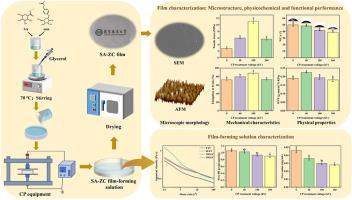不同电压下冷等离子体对海藻酸钠-玉米蛋白复合膜的改性及表征
IF 11
1区 农林科学
Q1 CHEMISTRY, APPLIED
引用次数: 0
摘要
冷等离子体(CP)是一种创新的非热技术,在修饰大分子复合物方面具有潜在的应用前景。本研究以海藻酸钠-玉米蛋白复合物(SA-ZC)溶液为研究对象,在0、40、100和160 kV电压下进行CP处理,分析了SA-ZC溶液及其膜的性能变化。结果表明,CP处理显著提高了SA-ZC溶液的粘度和粒径,同时降低了SA-ZC溶液的电负性、游离巯基和氨基含量,表明分子间相互作用增强。值得注意的是,100 kV处理显著提高了薄膜的力学性能、亲水性和热稳定性(降解温度从214.43℃提高到217.01℃)。FTIR、XRD和AFM分析表明,氢键的形成、有序度和结晶度的提高以及表面粗糙度是性能提高的主要原因。而CP处理对膜透明度和抗菌抗氧化活性无显著影响。这些发现表明,CP处理增强了SA-ZC溶液中的分子间相互作用,包括二硫键和氢键,最终改善了所得膜的性能。这提供了对CP机制的基本见解,并为开发修改应用程序提供了有希望的途径。本文章由计算机程序翻译,如有差异,请以英文原文为准。

Modification and characterization of sodium alginate-zein composite films by cold plasma at different voltages
Cold plasma (CP) is an innovative non-thermal technology with potential applications in the modification of macromolecular complexes. In this study, sodium alginate–zein composite (SA-ZC) solutions were treated with CP at different voltages (0, 40, 100, and 160 kV), and changes in the properties of SA-ZC solutions and their films were analyzed. The results indicated that CP treatment significantly increased the viscosity and particle size of the SA-ZC solution while reducing the electronegativity, free sulfhydryl and amino group contents, suggesting enhanced intermolecular interactions. Notably, 100 kV treatment significantly enhanced the film's mechanical properties, hydrophilicity, and thermal stability (with degradation temperature increasing from 214.43 to 217.01 °C). FTIR, XRD, and AFM analyses revealed that the formation of hydrogen bonds, increased orderliness and crystallinity, and surface roughness were the primary reasons for the improved performance. However, CP treatment had no significant effect on film transparency or on antibacterial and antioxidant activities. These findings demonstrate that CP treatment enhances intermolecular interactions including disulfide and hydrogen bonds in the SA-ZC solution, ultimately improving the resultant film's performance. This provides fundamental insight into CP's mechanism and suggests promising avenues for developing modification applications.
求助全文
通过发布文献求助,成功后即可免费获取论文全文。
去求助
来源期刊

Food Hydrocolloids
工程技术-食品科技
CiteScore
19.90
自引率
14.00%
发文量
871
审稿时长
37 days
期刊介绍:
Food Hydrocolloids publishes original and innovative research focused on the characterization, functional properties, and applications of hydrocolloid materials used in food products. These hydrocolloids, defined as polysaccharides and proteins of commercial importance, are added to control aspects such as texture, stability, rheology, and sensory properties. The research's primary emphasis should be on the hydrocolloids themselves, with thorough descriptions of their source, nature, and physicochemical characteristics. Manuscripts are expected to clearly outline specific aims and objectives, include a fundamental discussion of research findings at the molecular level, and address the significance of the results. Studies on hydrocolloids in complex formulations should concentrate on their overall properties and mechanisms of action, while simple formulation development studies may not be considered for publication.
The main areas of interest are:
-Chemical and physicochemical characterisation
Thermal properties including glass transitions and conformational changes-
Rheological properties including viscosity, viscoelastic properties and gelation behaviour-
The influence on organoleptic properties-
Interfacial properties including stabilisation of dispersions, emulsions and foams-
Film forming properties with application to edible films and active packaging-
Encapsulation and controlled release of active compounds-
The influence on health including their role as dietary fibre-
Manipulation of hydrocolloid structure and functionality through chemical, biochemical and physical processes-
New hydrocolloids and hydrocolloid sources of commercial potential.
The Journal also publishes Review articles that provide an overview of the latest developments in topics of specific interest to researchers in this field of activity.
 求助内容:
求助内容: 应助结果提醒方式:
应助结果提醒方式:


